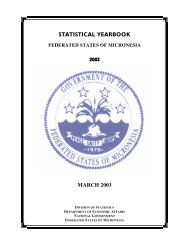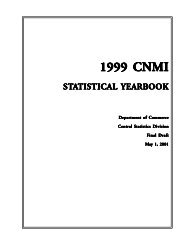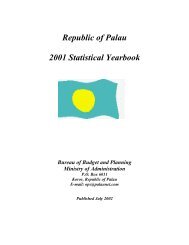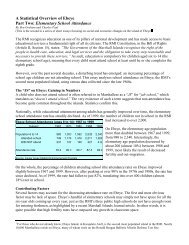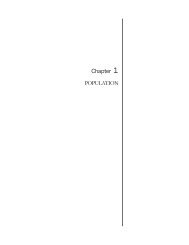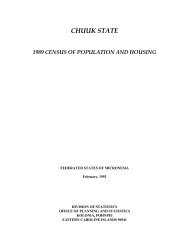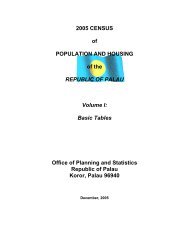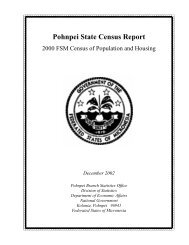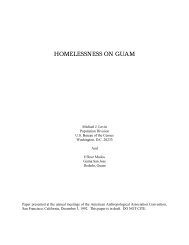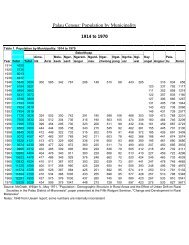Chuuk State Census Report - pacificweb.org
Chuuk State Census Report - pacificweb.org
Chuuk State Census Report - pacificweb.org
Create successful ePaper yourself
Turn your PDF publications into a flip-book with our unique Google optimized e-Paper software.
Chapter 3. Households, Families, and Marital Status2000 FSM <strong>Census</strong> of <strong>Chuuk</strong> <strong>State</strong>Brother/sister -- the brother or sister of the householder, including stepbrothers and stepsisters as well as adoptedbrothers and sisters.Father/mother -- parents of the householder by birth, stepparents, and parents of adoption excluding parents-in-law.Other relative -- a person who was related to the householder by blood, marriage, or adoption. ( In-laws, nephews,aunts, cousins, grand parents and so forth ).Non-relative -- a person who was not related by blood, marriage, or adoption to the householder or who could not bedescribed by the categories given.Marital StatusQuestion 5 asked for marital status of all residents. However, data were tabulated for persons aged 15 years and older.Marital status referred to the status at the time of enumeration. Traditional marriages were classified under nowmarried.The five marital categories were: never married: now married, widowed, divorced, and separated. They are definedbelow:Never married -- persons who never had been married, including persons whose only marriages were annulled.Now married -- all persons whose current marriage had not ended by widowhood or divorce.Widowed -- person whose spouse had died.Divorced -- person who had legally divorced his or her spouse.Separated --persons legally separated or otherwise absent from their spouse because of marital discord. Included werepersons who had been deserted or who had parted because they no longer wanted to live together but who had notobtained a divorce.When a person did not report his or her marital status, the Division of Statistics imputed the information according tothe relationship to the householder and sex and age of the person.Limitations and comparability. The results from the 1973, 1989, 1994 <strong>Census</strong>es were used in the 2000 FSM <strong>Census</strong>of <strong>Chuuk</strong> <strong>State</strong> analysis because the data are comparable.For the 2000 FSM <strong>Census</strong>, the definition used for Group Quarters was the same as that in the 1994 <strong>Census</strong>. The 2000<strong>Census</strong> of <strong>Chuuk</strong> <strong>State</strong> classified the following types of other group quarters as institutional rather than noninstitutionalgroup quarters: wards in general hospitals for patients who had no usual home elsewhere. These changesshould not significantly affect the comparability of data with earlier censuses because of the relatively small number ofpersons involved, except for that of 1973 or earlier censuses.As in 1980, 10 or more unrelated persons living together were classified as living in non-institutional group quarters.In 1973 or earlier census, the criterion was six or more unrelated persons. Therefore, the 1973 <strong>Census</strong> result on numberof household per housing unit was not directly comparable to the recent census. Several changes also occurred in theidentification of specific types of group quarters. The 1994 and 2000 FSM <strong>Census</strong>es of <strong>Chuuk</strong> <strong>State</strong> identifiedseparately the following types of correctional institutions: jails and police lockups.The 1994 and 2000 FSM <strong>Census</strong>es of <strong>Chuuk</strong> classified workers' dormitories as group quarters regardless of the numberof persons sharing the dorm. In 1980, 10 or more unrelated persons had to share the dorm for it to be classified asgroup quarters. In 1960, data on persons in military barracks were shown only for men; in subsequent censuses, theyincluded both men and women.In the 1994 and 2000 FSM <strong>Census</strong>es of <strong>Chuuk</strong> data products, the phrase "inmates of institutions" was changed to"institutionalized persons." Also, persons living in non-institutional group quarters were referred to as "other personsin-group quarters," and the phrase "staff residents" was used for staff living in institutions.28 <strong>Chuuk</strong> Branch Statistics Office, Division of Statistics, FSM Department of Economic Affairs



